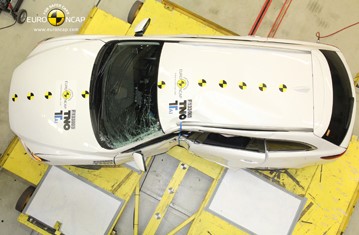Find more information in the General Comments section of the assessment
Find more information in the Rating Validity tab of the assessment
- See More
- See More
- See More
- See More
- Good
- Adequate
- Marginal
- Weak
- Poor
 Passenger
Passenger
 Driver
Driver
 Front Seat
Front Seat
 Car
Car
 Pole
Pole
- Good
- Adequate
- Marginal
- Weak
- Poor


Passenger
outboard
center
Fitted to the vehicle as standard
Not fitted to the test vehicle but available as option
Not Available
-
Infants up to 13 kg
-
Infants and toddlers up to 18 kg
-
Toddlers from 9 to 18 kg
-
Toddlers over 18 kg
Easy
Difficult
Safety critical
Not allowed
| Seat Position | ||||
|---|---|---|---|---|
| Front | 2nd row | |||
| Passenger | Left | center | Right | |
| Maxi Cosi Cabriofix (Belt) | ||||
| Britax Römer King Plus (Belt) | ||||
| Britax Römer Duo Plus (ISOFIX) | ||||
| Britax Römer KidFix (Belt) | ||||
| Maxi Cosi Cabriofix & EasyFix (Belt) | ||||
| Maxi Cosi Cabriofix & EasyFix (ISOFIX) | ||||
| BeSafe iZi Kid X3 ISOfix (ISOFIX) | ||||
| Maxi Cosi Pearl & Familyfix (ISOFIX) | ||||
| Britax Römer KidFix (ISOFIX) | ||||
Easy
Difficult
Safety critical
Not allowed
Based on dummy readings in the impact tests, the Mazda 6 scored maximum points for its protection of the 1½ year infant. Forward movement of the 3 year dummy, sat in a forward-facing restraint, was not excessive but the dummy's head contacted the rear head restraint on rebound. Although the contact was not hard, the car was penalised for poor control of the dummy movement, losing all points for the head. The passenger airbag can be disabled to allow a rearward-facing restraint to be used in that seating position. Clear information is provided to the driver regarding the status of the airbag and the system was rewarded. The child restraints which the car is designed to accommodate could be installed without a problem, except for the Group II/III restraint in the rear outboard seats which needed careful guidance of the ISOFIX probes in order to be properly fitted. Cars before VIN JMZGJ622621142289 have different cut-outs for the ISOFIX anchorages and installation of child restraints may differ slightly from the cars assessed by Euro NCAP.
- Good
- Adequate
- Marginal
- Weak
- Poor

Head Impact 17.8 Pts
Pelvis Impact 0.0 Pts
Leg Impact 6.0 Pts
The bumper scored maximum points for its protection of pedestrians' legs. However, the front edge of the bonnet offered poor protection to the pelvis of a struck pedestrian and scored no points. On the bonnet surface, head protection was predominantly good or adequate.
- Good
- Adequate
- Marginal
- Weak
- Poor
| Speed Limitation Function | Manually Set |
| System Name | DSC | |
| Performance | ||
| Vehicle Yaw Rate @ COS + 1.00 s | 1.535% | meets ECE requirements |
| Vehicle Yaw Rate @ COS + 1.75 s | 1.45% | meets ECE requirements |
| Lateral Displacement @ BOS + 1.07 s | 3.15 m | meets ECE requirements |
| Applies To | All seats | ||
| Warning | Driver Seat | Front Passenger(s) | Rear Passenger(s) |
| Visual | |||
| Audible | |||
|
|||
Electronic stability control is standard equipment and met Euro NCAP's test requirements. All seating positions are covered by a standard-fit seatbelt reminder. Cars from VIN JMZGJ622621142289 have a driver-set speed limitation device which met Euro NCAP's requirements for such systems.
- Specifications
- Safety Equipment
- Videos
- Rating Validity
Specifications
Tested Model Mazda 6, 2.2DE Wagon, 'Core' grade, LHD
Body Type - 5 door wagon
Year Of Publication 2013
Kerb Weight 1420kg
VIN From Which Rating Applies - from JMZGJ622621142289
Class Large Family Car
Safety Equipment
Note: Other equipment may be available on the vehicle but was not considered in the test year.
Fitted to the vehicle as standard
Fitted to the vehicle as option
Not fitted to the test vehicle but available as option
Not Available
Not Applicable
Videos
Rating Validity






Find more information in the General Comments section of the assessment
 Share
Share









The passenger compartment remained stable in the frontal impact. Dummy readings indicated good protection of the knees and femurs of both the driver and passenger. Mazda showed that a similar level of protection would be provided for occupants of different sizes and to those sat in different positions. In the side barrier test, dummy readings showed good protection of all body areas. However, the driver's door was found not to be fully latched when the car was inspected after the test and the car was penalised. There were no such problems in the side pole test and the car demonstrated adequate protection of the chest and good protection of all other body areas. The seat and head restraint provided good protection against whiplash injury in the event of a rear-end collision.